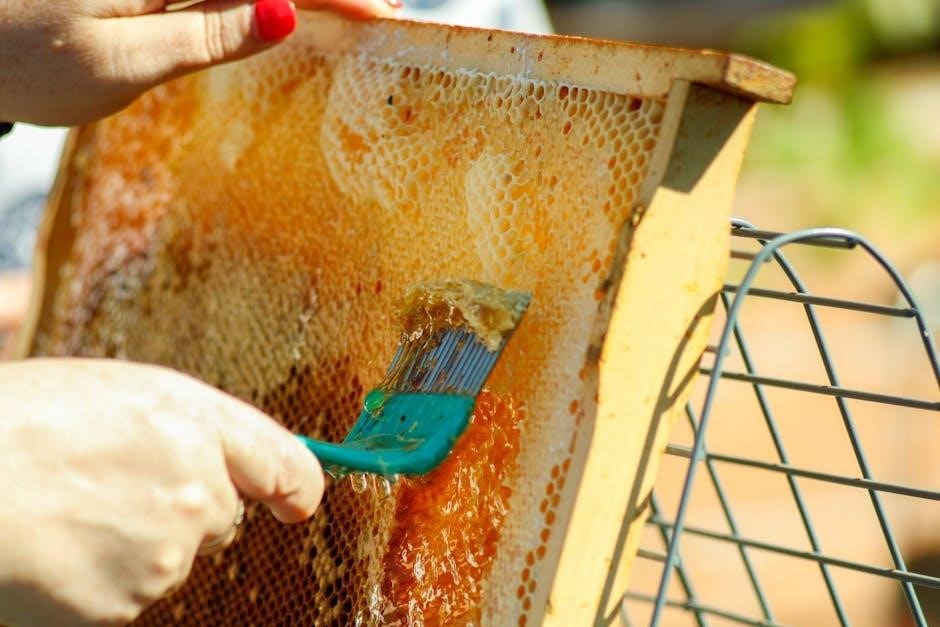Manual extraction is a foundational technique in molecular biology, involving physical or chemical methods to isolate nucleic acids from biological samples. It remains a cost-effective, straightforward approach for routine laboratory and diagnostic applications, offering simplicity and accessibility despite its labor-intensive nature and contamination risks.
Overview of Manual Extraction Techniques
Manual extraction techniques involve various laboratory methods to isolate nucleic acids or other biomolecules from samples. Common approaches include phenol-chloroform extraction, solid-phase extraction, and precipitation-based methods. Phenol-chloroform separates DNA from proteins and other cellular components using organic solvents, while solid-phase extraction uses spin columns to capture DNA on silica matrices. Precipitation methods rely on salts or ethanol to isolate DNA. Other techniques, like boiling lysis or salting-out, simplify the process for specific samples. These methods are cost-effective and adaptable but often require extensive hands-on time, increasing the risk of contamination and variability. They remain essential for small-scale, low-cost applications in molecular biology.
Importance of Manual Extraction in Scientific Processes
Manual extraction plays a crucial role in scientific processes as a foundational method for isolating biomolecules like DNA and RNA. It is widely used in molecular biology due to its simplicity, cost-effectiveness, and accessibility, making it ideal for small-scale applications. Manual techniques provide hands-on experience, which is essential for training researchers and understanding the principles of nucleic acid purification. Additionally, manual extraction serves as a reliable backup when automated systems are unavailable. Its adaptability to specific sample types, such as forensic or clinical specimens, ensures its continued relevance in scientific workflows, even as automated methods gain prominence.

Common Methods of Manual Extraction
Common methods of manual extraction include phenol-chloroform, solid-phase extraction, and precipitation-based techniques, each offering distinct advantages for isolating nucleic acids from biological samples.
Phenol-Chloroform Extraction
Phenol-chloroform extraction is a classic method for isolating DNA by separating it from proteins and other cellular components using organic solvents. It involves mixing biological samples with phenol and chloroform, which denature proteins and facilitate DNA partitioning into the aqueous phase. After centrifugation, DNA is precipitated and collected. This technique is effective but time-consuming and hazardous due to the use of toxic chemicals. Despite these drawbacks, it remains a widely used manual extraction method in laboratories due to its reliability and compatibility with various sample types, including blood and tissues.
Solid-Phase Extraction

Solid-phase extraction (SPE) is a widely used manual extraction method that employs a spin column containing silica matrices, magnetic beads, or other adsorbent materials. DNA binds to the solid phase while impurities are washed away, enabling efficient purification. This technique is favored for its simplicity, speed, and reduced risk of contamination compared to liquid-liquid methods. It involves loading the sample onto the column, washing with buffers, and eluting the purified DNA. SPE is particularly effective for small-scale DNA purification and is often integrated into kits for forensic and clinical samples, offering a balance between yield and ease of use.
Precipitation-Based Methods
Precipitation-based methods are manual extraction techniques that use chemical agents to separate DNA from other cellular components. Salting-out is a common approach, where high salt concentrations reduce DNA solubility, enabling precipitation. This method is simple, cost-effective, and non-toxic, making it ideal for isolating high-quality DNA from whole blood or tissues. DNA precipitation can also be achieved using ethanol or isopropanol, which are commonly used due to their ability to rapidly precipitate nucleic acids. These methods are particularly useful for large DNA fragments and are often employed in forensic and clinical settings, offering a reliable alternative to other extraction techniques with minimal specialized equipment.

Manual vs. Automated Extraction
Manual extraction is labor-intensive and cost-effective, while automated extraction offers speed, consistency, and scalability, reducing human error and increasing throughput, though requiring significant initial investment.

Advantages and Disadvantages of Manual Extraction
Manual extraction is cost-effective and straightforward, requiring minimal equipment, making it accessible for small-scale operations. It allows for customization and handling of diverse sample types. However, it is time-consuming, labor-intensive, and prone to human error. Hazardous chemicals like phenol and chloroform pose safety risks. The process is less standardized, leading to variability in results. Contamination risks are higher due to multiple handling steps. Despite these drawbacks, manual extraction remains a practical choice for low-throughput and specialized applications where cost and simplicity are prioritized over speed and consistency.
Comparison of Yield, Purity, and Cost
Manual extraction methods often yield lower purity and consistency compared to automated systems but are more cost-effective for small-scale applications. While manual techniques can achieve decent DNA quality, they are labor-intensive and prone to variability. Automated methods generally offer higher yield, purity, and reproducibility but come at a higher initial cost. However, automated systems may offset costs through increased efficiency and reduced labor. Manual extraction remains a practical choice for low-budget, low-throughput settings, while automated systems are preferred for high-throughput and standardized processes. The choice depends on balancing yield, purity, and cost against laboratory needs and resources.

Specific Techniques in Manual Extraction
Specific manual extraction techniques include boiling lysis and salting-out methods, which are efficient, non-toxic, and yield high-quality DNA, ideal for various biological samples and applications.
Boiling Lysis Method
The boiling lysis method is a simple and rapid manual extraction technique primarily used for DNA isolation. It involves heating the sample at a high temperature, typically near boiling point, to lyse cells and release DNA. This method is particularly effective for bacterial and viral samples, as it quickly disrupts cell membranes and inactivates nucleases. The process is cost-effective and avoids the use of hazardous chemicals, making it a popular choice in basic laboratory settings. However, it may not provide high-purity DNA, limiting its use in applications requiring stringent quality control. Despite this, its simplicity makes it a valuable tool in routine DNA extraction workflows.
Salting-Out DNA Extraction
The salting-out DNA extraction method is a straightforward and non-toxic technique for isolating high-quality DNA from biological samples, particularly whole blood. This process leverages varying salt concentrations to selectively precipitate DNA while leaving proteins and other contaminants in solution. It is a manual extraction method that avoids the use of organic solvents, making it safer and less hazardous compared to phenol-chloroform extraction. The simplicity of the salting-out method contributes to its cost-effectiveness and ease of use in basic laboratory settings. However, it can be time-consuming and carries a higher risk of contamination due to the multiple manual steps involved. Despite these limitations, it remains a reliable option for DNA extraction in routine applications.

Challenges and Limitations
Manual extraction is time-consuming, labor-intensive, and prone to contamination. It often lacks consistency, requires extensive pipetting, and is less accurate compared to automated methods.
Risk of Contamination
Manual extraction processes are highly susceptible to contamination due to the numerous manipulations and handling steps involved. The increased exposure of samples to environmental factors raises the likelihood of introducing airborne particles, skin cells, or other foreign substances. This risk is further compounded by the complexity of the procedures, which require precise handling and often involve hazardous materials. Contamination can lead to compromised results, making it essential to implement stringent aseptic techniques and quality control measures. Despite these precautions, manual methods remain more prone to contamination compared to automated systems, which minimize human intervention and reduce such risks significantly.
Time-Consuming and Labor-Intensive Processes
Manual extraction is inherently time-consuming and labor-intensive, requiring extensive hands-on preparation and handling. Each sample often necessitates multiple, meticulous steps, such as pipetting, mixing, and centrifugation, which can significantly delay processing times. This-intensive nature makes it challenging to handle large sample volumes efficiently. Additionally, the technical skill required for precise execution adds to the overall labor burden. While manual methods are cost-effective for small-scale operations, they become impractical when high throughput is needed, highlighting the need for automation in scaling up extraction processes to meet modern scientific demands.

Efficiency and Accuracy in Manual Extraction
Manual extraction’s efficiency and accuracy depend on proper training and standardized protocols. Ensuring consistent results while minimizing errors and contamination risks, though it remains less scalable than automated methods.
Optimizing Manual Extraction Processes
Optimizing manual extraction processes involves standardizing protocols to enhance yield, purity, and consistency. Techniques like silica matrices, magnetic beads, or lysis buffers can improve efficiency. Proper training and adherence to protocols reduce contamination risks. Regularly testing reagents and equipment ensures reliability. Simplifying steps without compromising quality helps maintain accuracy. Balancing simplicity with precision is key to achieving reliable results while keeping the process cost-effective and accessible for routine applications. These optimizations aim to maximize the effectiveness of manual extraction, making it a viable option despite its labor-intensive nature.
Reducing Errors and Improving Consistency

Minimizing errors in manual extraction requires strict adherence to standardized protocols and proper training. Implementing quality control measures, such as testing reagents and equipment, ensures reproducibility. Reducing contamination risks through sterile techniques and using high-quality materials further enhances consistency. Simplifying multi-step processes and minimizing pipetting steps can reduce human error. Regularly reviewing and refining protocols helps maintain accuracy. By addressing these factors, manual extraction can achieve consistent results, despite its labor-intensive nature and reliance on skilled personnel. These improvements are critical for maintaining reliability in scientific and diagnostic applications where precision is paramount.
